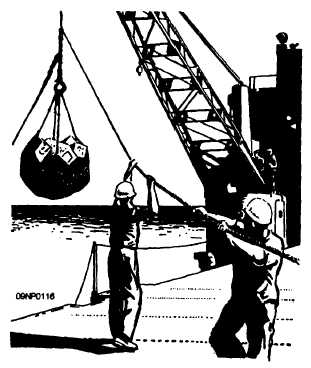| |
from which specially designed hooks are suspended at
front and rear (figure 13-16C). The attachment is
lowered over the drums until the hooks drop into
position over the drum rims. This attdachment handles
two filled drums at one time. The third type of
attachment, which is vertically operated, handles one
filled drum at a time. (See figure 1346 D.) The fourth
type of drum-handling attachment operates on the
principle of vacuum. This attachment is not in wide use.
This is because of the expense involved in the
installation of this attachment and the fact that once
installed the use of the forklift truck is restricted to drum
handling only.
CARGO NET SLING
The cargo net sling (figure 13-1 7) is made of nylon
straps cargo together in a crisscross pattern to form a 12
foot square or 14 foot square net. The four comers of
the net have steel rings sewn in for the pickup hoist
hooks or lines used to form an apex. In this type of sling
no bars are used as supports. The idea being that the net
closes about the material being lifted.
Cargo net slings are generally used aboard Combat
Logistics Force (CLF) ships for underway
replenishment (UNREP) operations support. Pallets of
cargo can be placed in the net and transferred with a
minimum of loss. Some ships use cargo net slings for
handling miscellaneous cargo that is placed directly into
the net as shown in figure 13-17.
ROLLERS, CONVEYORS, AND CHUTES
Conditions may be such that rollers conveyors, or
chutes are more effective than mobile equipment or may
supplement mobile equipment when a deficiency of
mobile equipment exists.
Rollers
Hardwood rollers or pipes may be placed under
heavy boxes or skids so that they maybe moved about
in a storeroom or vehicle. Two or more rollers are used,
depending on the weight of the box. The end of the box
toward the direction in which the box is to be moved is
raised by a hoist, lever, or other lifting device, and a
roller is placed under it. The box is then pushed forward
as more rollers are placed in front of it. As the box
passes off a roller, the roller is picked up and placed in
front of the box.
Figure 13-17.—Cargo net sling.
Conveyors
A conveyor is a device for moving supplies in a
fixed line of travel. Two basic types of conveyors have
been adopted as standard for the military departments,
the powerdriven belt conveyor and the gravity-type
roller or wheel conveyor.
The power-driven belt conveyor consists of an
endless belt mounted on a frame and driven by a pulley
connected to a drive motor. The belt travels over a
series of rollers or a sliding bed. The belt conveyor can
be used to transport materials over a fixed path of travel
up inclines of as much as 25 degrees.
The roller conveyor can be installed with one end
lower than the other to take advantage of gravity. It can
also be installed level and the load pushed along
manually. Several sections can be put together and
developed into a continuous system for movement of
material. The conveyor can be used on piers, in
storerooms, or wherever a steady flow of supplies is
desired. A drop of one-half inch per foot is usually
required to keep an object in motion on the rollers.
Figure 13-18 shows their use in clearing the landing
area of the receiving ship during underway
replenishment. Folding stands maybe used when it is
necessary to clear obstructions on the deck or to pass
through doors. Accesories for horizontal conveyors
include turntables and curved sections.
13-8
|

